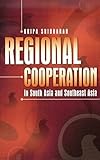Regional Cooperation in South Asia and Southeast Asia / Kripa Sridharan.
Material type: TextPublisher: Singapore : ISEAS Publishing, [2007]Copyright date: ©2007Description: 1 online resource (382 p.)Content type:
TextPublisher: Singapore : ISEAS Publishing, [2007]Copyright date: ©2007Description: 1 online resource (382 p.)Content type: - 9789812304353
- 9789812307200
- 337.15 22
- JQ98.A38 R437 2007
- JQ98.A38
- online - DeGruyter
| Item type | Current library | Call number | URL | Status | Notes | Barcode | |
|---|---|---|---|---|---|---|---|
 eBook
eBook
|
Biblioteca "Angelicum" Pont. Univ. S.Tommaso d'Aquino Nuvola online | online - DeGruyter (Browse shelf(Opens below)) | Online access | Not for loan (Accesso limitato) | Accesso per gli utenti autorizzati / Access for authorized users | (dgr)9789812307200 |
Frontmatter -- Contents -- Preface -- 1. INTRODUCTION: WHY REGIONALISM? -- 2. REGIONALISM: THE INSTITUTIONAL FRAMEWORK -- 3. THE POLITICAL DIMENSION OF REGIONALISM -- 4. PATTERNS OF ECONOMIC REGIONALISM -- 5. SOCIAL ISSUES AND REGIONAL COOPERATION -- 6. SUMMARY AND CONCLUSION -- Index -- About the Authors
restricted access online access with authorization star
http://purl.org/coar/access_right/c_16ec
The general view about regionalism seems to be that it is better to have regionalized and faltered than never to have regionalized at all! Inspired by this observation, this study aims to provide a comparative sketch of regionalism in South and Southeast Asia in the light of recent regional developments. Since regionalism is both a pervasive and amorphous phenomenon a straightforward account of its similarities and differences cannot be easily set down. But the broad patterns of behaviour of the regional actors who gather under a regional roof can be captured and compared. To compare is not only to understand but to improve and avoid the avoidable. This book analyses the highs and lows of regional experience mainly in South Asia (South Asian Association for Regional Cooperation or SAARC) and Southeast Asia (Association of Southeast Asian Nations or ASEAN) interspersed with references to the European Union (EU) where relevant. The book argues that regionalism is here to stay and both imitation and innovation are the preferred strategies for sustaining the process. It points out that economic integration requires certain prior conditions to be fulfilled and does not happen merely because governments wish it to happen.
Mode of access: Internet via World Wide Web.
In English.
Description based on online resource; title from PDF title page (publisher's Web site, viewed 01. Dez 2022)


